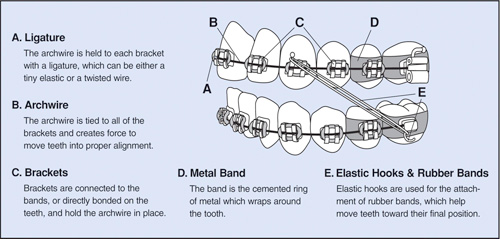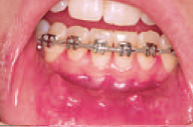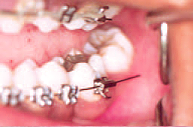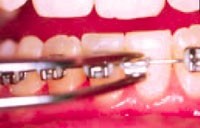Emergencies
With the right tools and a little “tender loving care” most orthodontic emergencies, though a little upsetting to the patient, are actually fairly simple to treat at home. The suggestions below can help alleviate discomfort.
Use the diagram below to help you describe your emergency situation. We will give you additional information or schedule a repair appointment based on information you provide us.

CLICK HERE for a convenient reference
Tools & Supplies
With these tools and supplies on hand (most of which you may already have), you will be prepared to handle the most common orthodontic emergencies.
- Non-medicated orthodontic relief wax
- Dental floss
- Clean tweezers
- Small, sharp nail clippers
- Q-tips
- Salt
- Interproximal brush
- Toothpicks
- Non-prescription pain reliever (acetaminophen or ibuprofen—whatever you normally take for a headache—confirm that no allergies to these medications are present)
- Topical Anesthetic (such as Orabase or Ora-Gel)
Emergency Treatments
The following orthodontic emergencies and their treatments are listed in the order of the least severe to the most severe. The majority of these are easily treated with a follow-up appointment scheduled on the next available day the office is open. Only the most severe emergencies may require immediate attention by an orthodontist.
Food Caught Between Teeth

Food Caught Between Teeth
This is not an emergency, but can be a little uncomfortable or embarrassing for the braces-wearing patient. It is easily fixed with a piece of dental floss. Try tying a small knot in the middle of the floss to help remove the food or use an interproximal brush or toothpick to dislodge food caught between teeth and braces.
Ligatures Come Off

Ligatures Come Off
Tiny colored rubber bands or small, fine wires, known as ligatures, hold the wire to the bracket. If a rubber ligature should come off, you may be able to put it back in place using sterile tweezers. If a wire ligature comes loose, simply remove it with clean tweezers. If the wire ligature is sticking out into the lip but is not loose, it may be bent back down with a Q-tip or pencil eraser to eliminate the irritation.
When one ligature pops off or breaks, others may follow. Call the office on the next available day the office is open to make a follow-up appointment.
Discomfort
It’s normal for a patient to have discomfort for a day or two after braces or retainers are adjusted, but it can make eating uncomfortable. Be reassured that the discomfort is both normal and temporary. We encourage you to eat soft foods and take small bites. Have a special menu of braces-friendly meals and comfort foods you plan to have following your orthodontic appointments to make it easier on your tender teeth. Some patients find it helpful to rinse their mouth with warm salt water rinses. If the patient has no medicine allergies, over-the-counter pain relievers, such as acetaminophen or ibuprofen, may be effective.
Mouth Sores

Mouth Sores
Some patients are susceptible to episodes of mouth sores. One or several areas of ulceration of the cheeks, lips or tongue may appear. This is not an emergency, but may be very uncomfortable for the patient. Prompt relief may be achieved by applying a small amount of topical anesthetic (such as Orabase or Ora-Gel) directly to the ulcerated surface using a cotton swab. Reapply as needed.
Irritation in Mouth

Use non-medicinal relief wax for buffer
New braces can be irritating to the mouth, especially when trying to eat. A small amount of non-medicinal relief wax makes an excellent buffer between metal and mouth. Simply pinch off a small piece and roll it into a ball. Dry the area where the wax will be applied by self-vacumming (sucking air in quickly and swallowing any excess saliva) or using a Q-tip. Flatten the ball and place it completely over the area of the braces causing irritation. If wax is accidentally ingested it’s not a problem; orthodontic wax is harmless.
Losing a Separator
Losing a separator is not an immediate emergency, but call our office to see whether it needs to be replaced.
Protruding Wire

Protruding Wire
Occasionally the end of a wire will work itself out of place and irritate the patient’s mouth. Use a Q-tip or pencil eraser to push the wire so that it is flat against the tooth. If the wire cannot be moved into a comfortable position, cover it with wax. Call the office on the next available day the office is open to make a follow-up appointment.
In a situation where the wire is extremely bothersome and the patient is not able to see the orthodontist anytime soon, as a last resort, you may clip the wire using a clean nail clipper.
Reduce the possibility of swallowing the snipped piece of wire by using folded tissue or gauze around the area. Use a pair of sharp clippers and snip off the protruding wire behind that last bracket. Relief wax may still be necessary to provide comfort to the irritated area.
Loose Wires, Brackets or Bands
Brackets are the parts of braces attached to teeth with a special adhesive. Ideally positioned on each tooth, the bracket can be knocked off from hard foods avoid or from trauma. A protective mouth guard is recommended for all athletes.
If the loose bracket has rotated on the wire and is sticking out, and the patient cannot immediately be taken to the orthodontist, you can do a temporary fix to alleviate discomfort and prevent further damage, but take care to prevent swallowing or other injury. To put the bracket back in place, use sterile tweezers to slide the bracket along the wire until it is between two teeth. Rotate the bracket back to the proper position, then slide it back to the center of the tooth. Call the office on the next available day the office is open to make a follow-up appointment to repair the broken brace.
Piece of Appliance is Swallowed
This is extremely rare, but when it does occur, REMAIN CALM. If the patient is coughing excessively or having difficulty breathing, the piece could have been aspirated. If you are able to see the piece, you may carefully attempt to remove it. But do not make the attempt if you could cause harm. If appropriate under the circumstances, examine the patient’s braces for problems that may result from the missing piece, such as looseness or irritation, and treat as specified above. If you are unable to see the piece and believe it may have been aspirated, notify the office immediately.
If you are in severe pain and require urgent assistance, please call the office 707-823-1200 to be connected to our emergency line.
We may ask you to text or email Photos to us to help resolve a solution to your urgent or non-urgent situation.
Photos courtesy of the Canadian Association of Orthodontists
Emergency information courtesy of the American Association of Orthodontists

An ounce of prevention is worth a pound of cure.”



